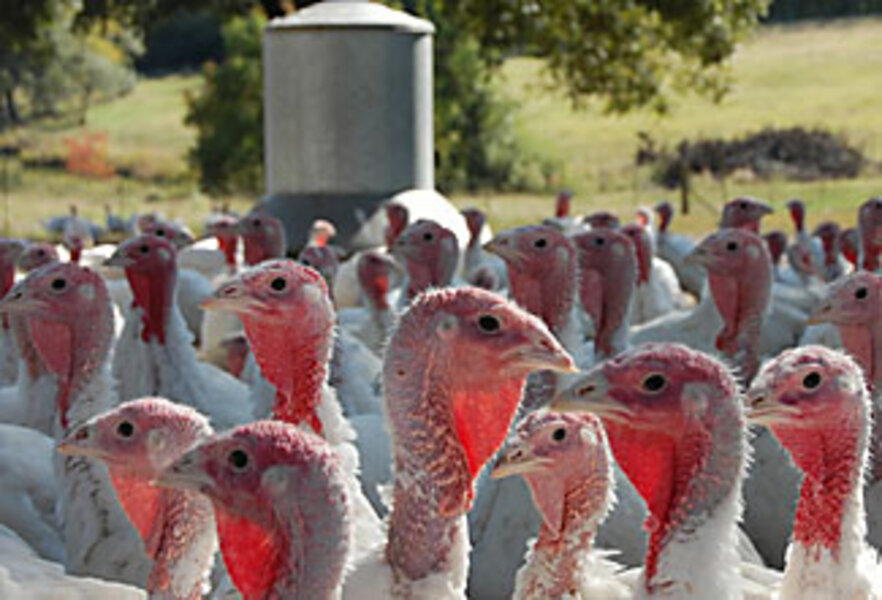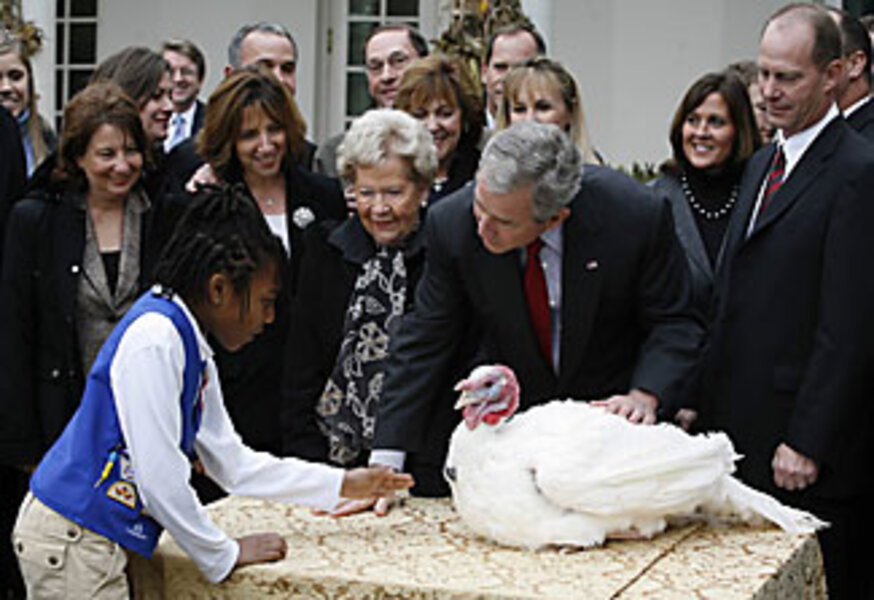For kids: Down on the turkey farm
Loading...
Each year, an estimated 271 million turkeys are bred in the United States. While most are raised by several large companies, there are still a few smaller, family-owned turkey farms scattered across the country.
In central Alabama, Bill Bates has been raising turkeys on his 900-acre farm since 1946. This year, he expects to produce about 60,000 free-range turkeys. These animals have lived mostly outdoors on about 30 acres of land dotted with shady pecan trees.
"We keep them inside until they're 7 weeks old, then move them outside," says Mr. Bates from his farm near Fort Deposit.
The male and female turkeys are raised separately because they have different nutritional requirements – the males are slightly larger and need more protein. Freshwater is pumped from a nearby lake, and massive 1,000-pound self-feeders tower over the birds to provide a banquet of corn 24 hours a day. It takes three to four months and about 75 pounds of corn to raise one of Mr. Bates's turkeys.
Like many bird species, turkeys tend to flock together for safety. But their snowy white feathers and bright red heads make young turkeys an easy target for hungry farm predators looking for a quick snack. So Mr. Bates uses electric fences and noisy cannons to scare off the coyotes, raccoons, and owls. The gas-powered cannons are placed around the farm and detonate with a loud "boom" every few minutes. "It doesn't bother the turkeys," says Mr. Bates. "They get used to it and go right on eating."
About 90 percent of all commercially raised turkeys have white feathers. But their ancestors actually had dark feathers. "It was done by selective breeding," explains Mr. Bates. He says that many years ago, scientists looked for dark- feathered birds that had a few white feathers, too. "They picked out the ones that had the most white feathers, and, after breeding for several generations, they produced a turkey that had all white feathers."
What's so special about white feathers on a turkey? The dye in dark feathers can sometimes stain the turkey flesh during processing. "It doesn't affect the nutritional value or taste," says Mr. Bates. "People just don't like to see dark spots in their meat!"
Mary Pitman's family also raises white turkeys on Mary's Free-Range Turkey farm near Fresno, Calif. But some of her 150,000 turkeys have dark feathers.
"They are heritage turkeys – a very old breed and known for their great flavor," said Ms. Pitman. "They take longer – seven to eight months – to raise. Unlike big farms where the turkeys are crowded, we give our birds plenty of open space to roam outside. Many people want a turkey that has been raised in a humane way."
Most of the turkeys produced by Ms. Pitman and Mr. Bates won't be around next season. But one fortunate bird from the Bates farm will be spared and presented to Alabama Gov. Bob Riley, who will grant it an official "pardon" just before Thanksgiving Day.
Patsy Riley, Alabama's first lady, likes to encourage people – including kids – to think less of turkey and Thanksgiving food and more about helping people who are less fortunate. She organizes Blankets With a Blessing, a program that collects and distributes blankets to shelters and the homeless.
The custom of pardoning a turkey, which is also practiced by other governors and the US president, is often said to have been started by Abraham Lincoln. But it's actually a more recent tradition. The first president to declare a formal turkey "pardon" was George H.W. Bush, in 1989. However, presidents have been presented with a Thanksgiving turkey from the National Turkey Federation since 1947, which is about the time Mr. Bates began giving turkeys to Alabama governors.
"This will be my 59th year of doing it," said Mr. Bates, who has named each of the birds Clyde. This year's Clyde will likely follow many of the Clydes before him and be returned to the Bates farm, where he will live out his days under those cool, shady pecan trees.
• A male turkey is called a tom, females are called hens, and a baby turkey is a poult.
• Male turkeys make a gobble sound, while females make a clucking or clicking sound.
• When astronauts Neil Armstrong and Buzz Aldrin landed on the moon, their first meal was turkey.
• Turkeys are now bred to be so big that they can no longer fly.
• A turkey has 157 bones.
• The world's biggest "turkey" is a 20-feet tall fiberglass statue in Frazee, Minn.
• The costume of Sesame Street's Big Bird is made from about 4,000 turkey feathers dyed yellow.
• Minnesota produces more turkeys than any other state.
• The average American consumed 17.5 pounds of turkey in 2007.
Sources: US Census Bureau, National Turkey Federation, the University of Illinois Extension, the city of Frazee






